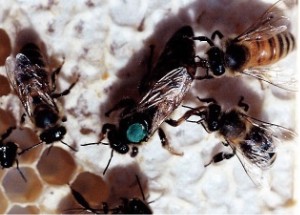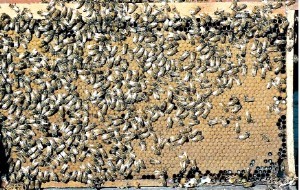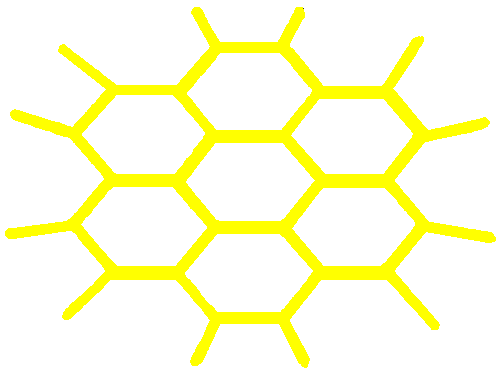
|
| Home | Queens | Honey Production | Employment | Contact Us | Research & Publications | Tours | Items For Sale | Links | FAQs |
|
Announcement
We would like to thank all of our customers over the years for your loyalty and support. Our
farm has changed with the retirement of 2 of our beekeepers and the
aging of another and therefore, the operations of our farm needs to
change as well. We
decided that 2018 would be the last year that we sold queens. We
will be focusing on raising queens for ourselves rather than for
market.
There are several reasons for the decision, but one of the main ones is that we believe that locally raised queens are best. To that end we will be adapting this page on the website to encourage people on how to, with little effort, select for traits and raise their own queens. Raising queens is still our favourite job and where we learn the most about the bees and beekeeping. We thank you for your support and interest and encourage you to step up to the challenge of raising your own queens. |

|


Green branded queen Yellow branded queen |
Detailed records are kept on each hive including honey production, spring build-up, temperment and varroa mite infestation. A weather proof card stays with each hive to note what was done to that hive and how it acted since it was started. We use a billet loader attached to a scale to strip honey. Those production records are downloaded directly into a computer to compare and analyze.
Breeder queens are selected from high producing colonies. As a result of the breeding program we continue to produce above average honey crops.
Mean-tempered bees are not tolerated at Pedersen Apiaries. Defensive hives are given two chances before the queen is replaced. Being able to handle the bees without protective gear is expected. We found that the Russian queen stock had set us back in this area. However, dilegent culling quickly got it under control.

Karen Pedersen
holding queen cells out of cell builder.
Harsh Saskatchewan winters require strong hives with productive queens to survive. Single story hives allow no room for wasted space or mistakes. The winter itself naturally selects the stronger healthier hives.
Our goal is to breed resistance into the bees instead of breeding the pathogens and parasites (diseases) to be resistant to medication. As part of a good disease prevention strategy, we mark our brood combs with a manufacturing date and cull brood combs when they reach 10 years old. Over several years we decreased our use of medication until we were able to just use limited medication to test for diseases. It was in 2005 that we totally cut out the use of preventative medication. Just like the Saskatchewan winters, we are trying to create the circumstances to allow diseases to cull out the susceptible stock over time without wiping out our operation or bees in one swoop. To do this, we have to be vigilant monitoring the diseases for prevalence and the bees for resistance or susceptibility. While we do not rule out the use of medication when necessary, we consider it a cost saving method to breed resistant stock and save medication to use as a last resort.

Brood comb from Pedersen Apiaries.Varroa Mite
We had tested 25% of our hives every year. In the spring of 2008 we found our first varroa mites in 3 yards. We are experimenting with several options to keep varroa under control until we find a method or methods that work for us.Tracheal Mite
In 1995 one yard with one tracheal mite in one bee out of 100 bees (1%) was found at Pedersen Apiaries. That yard had no more positive tests and was kept quarantined until 2000. After it was dequarantined another yard tested positive for tracheal mites at 1%. While we have tracheal mites, we have not treated for them specifically since the initial panic in 1995. However, we used a spring treatment of formic acid for varroa mites from 2011-2013 inclusively and then again in the fall of 2017. Formic acid also treats tracheal mites. Medhat Nasr tested our stock in 1998, 1999 and 2000 and found it highly resistant to tracheal mites.Foul Brood
We stopped feeding anti-biotics in 2005. We continue to monitor, but have seen no evidence of foul brood in our hives.Chalkbrood
After years of rejecting hives as potential breeders if we saw any chalkbrood in them, we rarely saw it in our hives. We found a resurgence of chalkbrood came with the Russian stock. Therefore, we are monitoring for chalkbrood and replacing queens with infestations.Sacbrood
We rarely see sacbrood.Nosema
We are monitoring Nosema levels, and treated with Fumagilin B in 2014 after many years without treatment. We are still trying to make sense of the current information surrounding Nosema treatment thresholds.
Our original stock was from California. To ensure genetic variety we have brought in queens from New Zealand, Austrailia, Hawaii and British Columbia. We brought in some tracheal mite resistant stock from Ontario by both eggs and semen. This included Buckfast stock. As part of another research project we incorporated Russian Bee Stock into our operation as well. Our stock is now predominately Russian, but in reality all of our queens are hybrid.In 2010 we stopped maintaining isolated mating yards to breed purebred Russian stock. Instead, we tested hives with 2 year old queens for varroa mites and bred from those with low levels of infestation.
We have chosen to breed for disease resistance, and save medication to use as a last resort.
We continue to experiment with different management techniques.
We do not breed on the basis of colour.
For more information contact:
|
Box 579 Cut Knife, SK S0M 0N0 Canada |
Karen Pedersen (306) 398-3633 fax: (306) 398-3602 |

Revised: January 16, 2019.
Copyright © 2002 Pedersen Apiaries. All rights reserved. Original Design & Graphics by Karen Pedersen Photographic images are under copyright and used with permission of John Pedersen or Karen Pedersen |